Leadership Management: Analyzing Styles and Theories at ICCR
VerifiedAdded on 2022/10/11
|13
|3790
|46
Report
AI Summary
This report critically analyzes various leadership theories, including the great man theory, trait theory, and behavioral theory, and evaluates their relevance in contemporary business settings. It examines the leadership styles of Rachel at ICCR, highlighting her output-oriented and employee-oriented approaches, and compares her style to transformational leadership. The report identifies strengths such as her focus on growth and employee welfare, while also pointing out weaknesses like communication gaps and potential loss of control. It assesses the leadership styles of department heads, noting their autocratic tendencies. The report concludes with recommendations to enhance the long-term viability of ICCR by addressing the identified issues and leveraging effective leadership strategies. The analysis emphasizes the importance of aligning leadership behaviors with organizational goals and employee needs for optimal performance and growth.
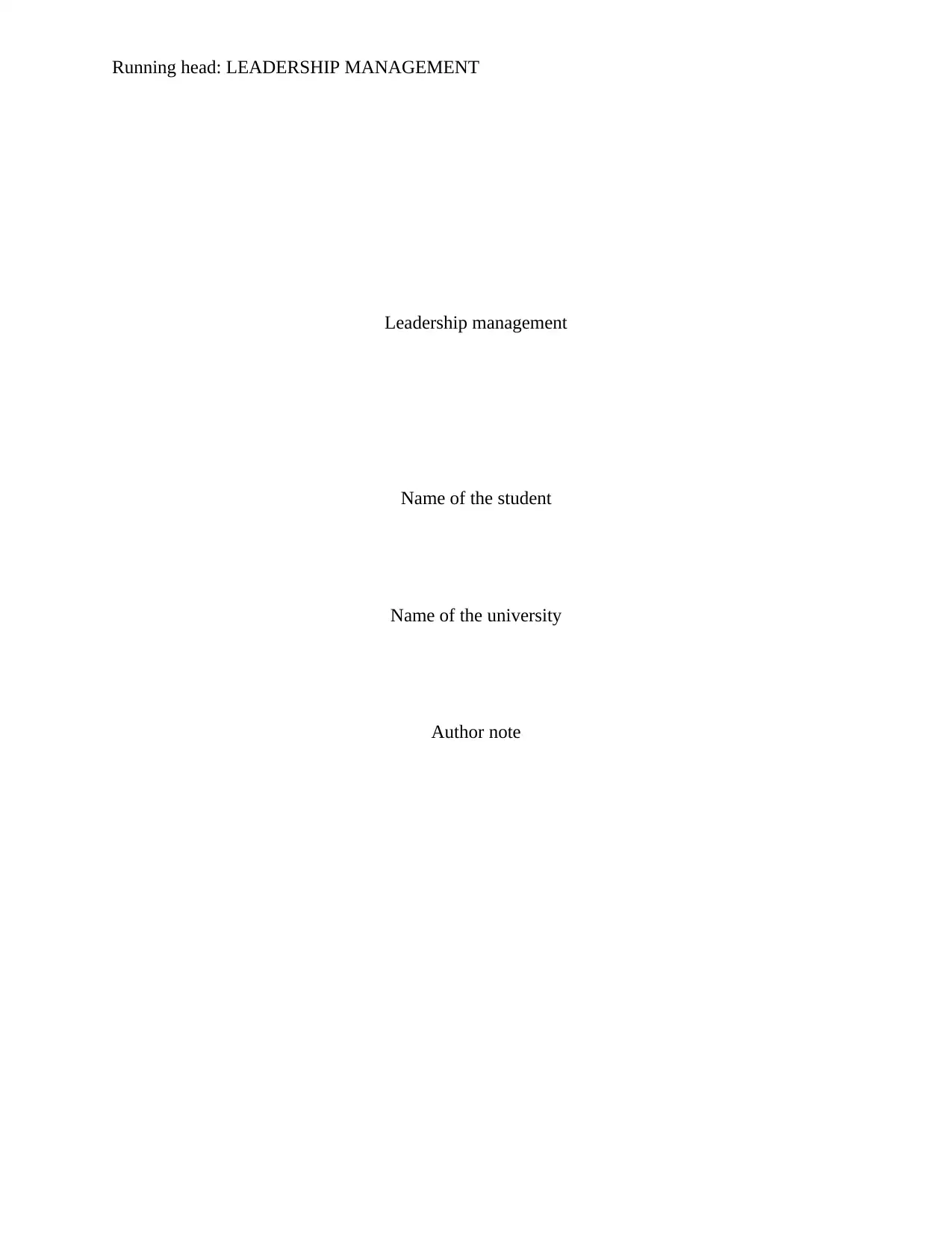
Running head: LEADERSHIP MANAGEMENT
Leadership management
Name of the student
Name of the university
Author note
Leadership management
Name of the student
Name of the university
Author note
Paraphrase This Document
Need a fresh take? Get an instant paraphrase of this document with our AI Paraphraser
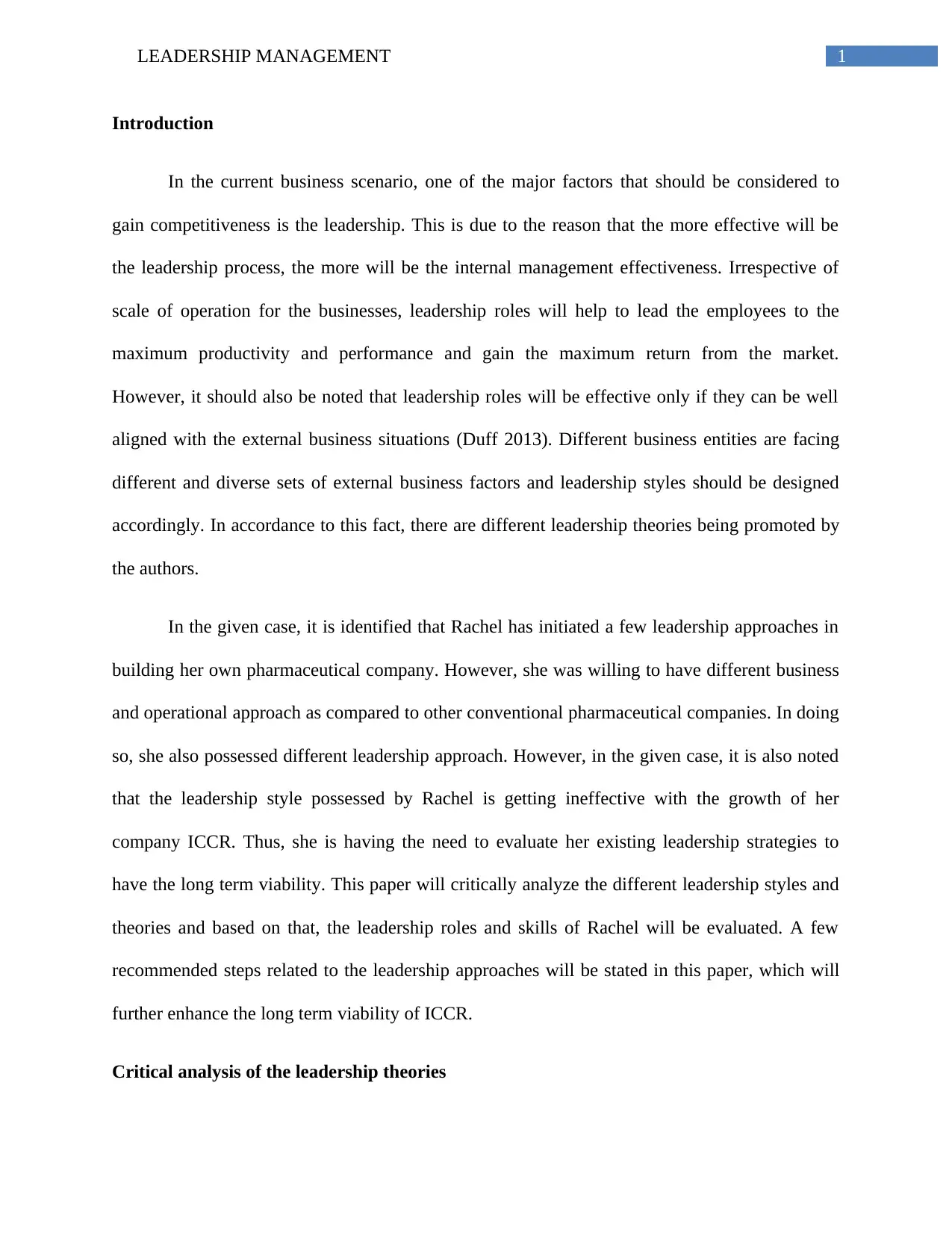
1LEADERSHIP MANAGEMENT
Introduction
In the current business scenario, one of the major factors that should be considered to
gain competitiveness is the leadership. This is due to the reason that the more effective will be
the leadership process, the more will be the internal management effectiveness. Irrespective of
scale of operation for the businesses, leadership roles will help to lead the employees to the
maximum productivity and performance and gain the maximum return from the market.
However, it should also be noted that leadership roles will be effective only if they can be well
aligned with the external business situations (Duff 2013). Different business entities are facing
different and diverse sets of external business factors and leadership styles should be designed
accordingly. In accordance to this fact, there are different leadership theories being promoted by
the authors.
In the given case, it is identified that Rachel has initiated a few leadership approaches in
building her own pharmaceutical company. However, she was willing to have different business
and operational approach as compared to other conventional pharmaceutical companies. In doing
so, she also possessed different leadership approach. However, in the given case, it is also noted
that the leadership style possessed by Rachel is getting ineffective with the growth of her
company ICCR. Thus, she is having the need to evaluate her existing leadership strategies to
have the long term viability. This paper will critically analyze the different leadership styles and
theories and based on that, the leadership roles and skills of Rachel will be evaluated. A few
recommended steps related to the leadership approaches will be stated in this paper, which will
further enhance the long term viability of ICCR.
Critical analysis of the leadership theories
Introduction
In the current business scenario, one of the major factors that should be considered to
gain competitiveness is the leadership. This is due to the reason that the more effective will be
the leadership process, the more will be the internal management effectiveness. Irrespective of
scale of operation for the businesses, leadership roles will help to lead the employees to the
maximum productivity and performance and gain the maximum return from the market.
However, it should also be noted that leadership roles will be effective only if they can be well
aligned with the external business situations (Duff 2013). Different business entities are facing
different and diverse sets of external business factors and leadership styles should be designed
accordingly. In accordance to this fact, there are different leadership theories being promoted by
the authors.
In the given case, it is identified that Rachel has initiated a few leadership approaches in
building her own pharmaceutical company. However, she was willing to have different business
and operational approach as compared to other conventional pharmaceutical companies. In doing
so, she also possessed different leadership approach. However, in the given case, it is also noted
that the leadership style possessed by Rachel is getting ineffective with the growth of her
company ICCR. Thus, she is having the need to evaluate her existing leadership strategies to
have the long term viability. This paper will critically analyze the different leadership styles and
theories and based on that, the leadership roles and skills of Rachel will be evaluated. A few
recommended steps related to the leadership approaches will be stated in this paper, which will
further enhance the long term viability of ICCR.
Critical analysis of the leadership theories
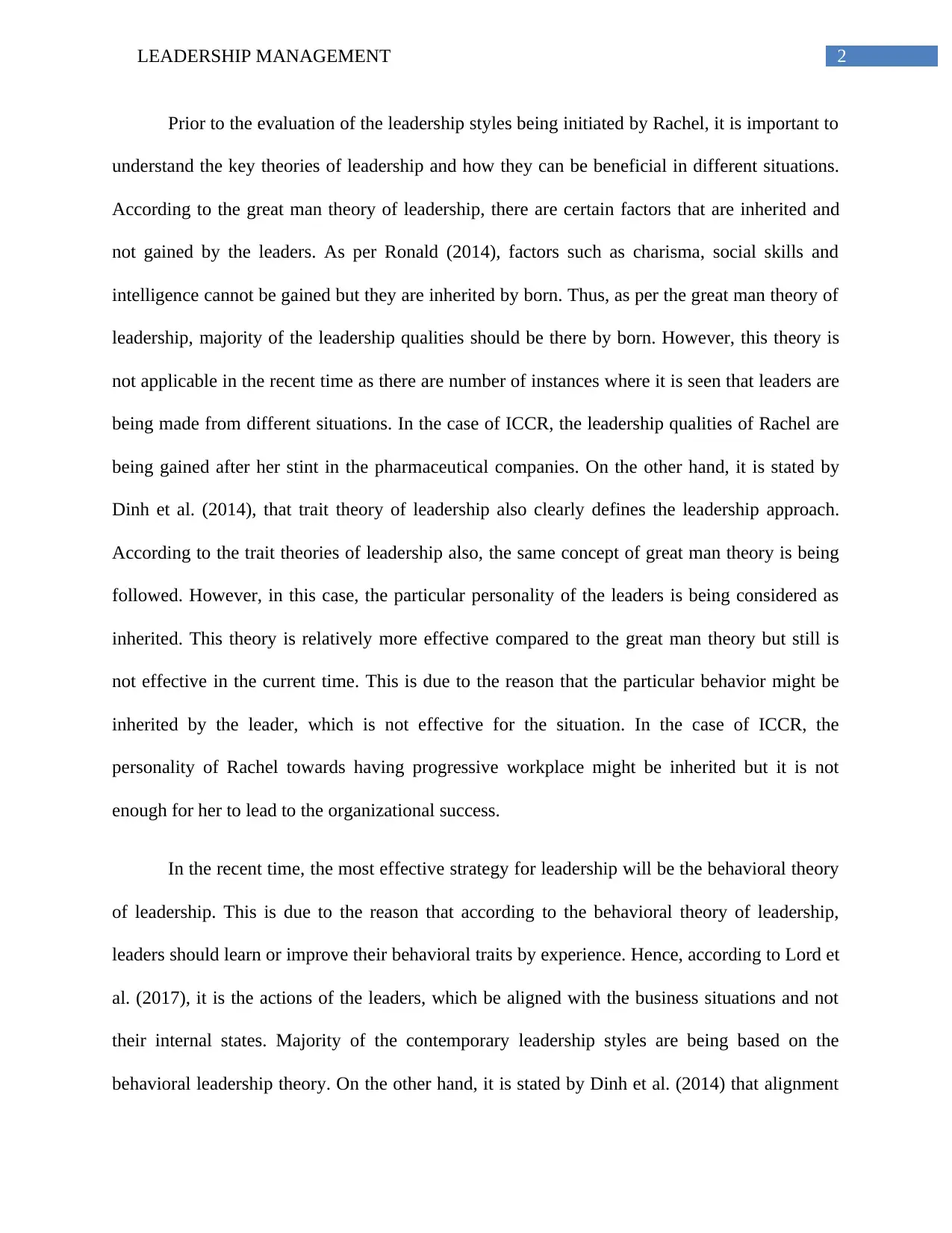
2LEADERSHIP MANAGEMENT
Prior to the evaluation of the leadership styles being initiated by Rachel, it is important to
understand the key theories of leadership and how they can be beneficial in different situations.
According to the great man theory of leadership, there are certain factors that are inherited and
not gained by the leaders. As per Ronald (2014), factors such as charisma, social skills and
intelligence cannot be gained but they are inherited by born. Thus, as per the great man theory of
leadership, majority of the leadership qualities should be there by born. However, this theory is
not applicable in the recent time as there are number of instances where it is seen that leaders are
being made from different situations. In the case of ICCR, the leadership qualities of Rachel are
being gained after her stint in the pharmaceutical companies. On the other hand, it is stated by
Dinh et al. (2014), that trait theory of leadership also clearly defines the leadership approach.
According to the trait theories of leadership also, the same concept of great man theory is being
followed. However, in this case, the particular personality of the leaders is being considered as
inherited. This theory is relatively more effective compared to the great man theory but still is
not effective in the current time. This is due to the reason that the particular behavior might be
inherited by the leader, which is not effective for the situation. In the case of ICCR, the
personality of Rachel towards having progressive workplace might be inherited but it is not
enough for her to lead to the organizational success.
In the recent time, the most effective strategy for leadership will be the behavioral theory
of leadership. This is due to the reason that according to the behavioral theory of leadership,
leaders should learn or improve their behavioral traits by experience. Hence, according to Lord et
al. (2017), it is the actions of the leaders, which be aligned with the business situations and not
their internal states. Majority of the contemporary leadership styles are being based on the
behavioral leadership theory. On the other hand, it is stated by Dinh et al. (2014) that alignment
Prior to the evaluation of the leadership styles being initiated by Rachel, it is important to
understand the key theories of leadership and how they can be beneficial in different situations.
According to the great man theory of leadership, there are certain factors that are inherited and
not gained by the leaders. As per Ronald (2014), factors such as charisma, social skills and
intelligence cannot be gained but they are inherited by born. Thus, as per the great man theory of
leadership, majority of the leadership qualities should be there by born. However, this theory is
not applicable in the recent time as there are number of instances where it is seen that leaders are
being made from different situations. In the case of ICCR, the leadership qualities of Rachel are
being gained after her stint in the pharmaceutical companies. On the other hand, it is stated by
Dinh et al. (2014), that trait theory of leadership also clearly defines the leadership approach.
According to the trait theories of leadership also, the same concept of great man theory is being
followed. However, in this case, the particular personality of the leaders is being considered as
inherited. This theory is relatively more effective compared to the great man theory but still is
not effective in the current time. This is due to the reason that the particular behavior might be
inherited by the leader, which is not effective for the situation. In the case of ICCR, the
personality of Rachel towards having progressive workplace might be inherited but it is not
enough for her to lead to the organizational success.
In the recent time, the most effective strategy for leadership will be the behavioral theory
of leadership. This is due to the reason that according to the behavioral theory of leadership,
leaders should learn or improve their behavioral traits by experience. Hence, according to Lord et
al. (2017), it is the actions of the leaders, which be aligned with the business situations and not
their internal states. Majority of the contemporary leadership styles are being based on the
behavioral leadership theory. On the other hand, it is stated by Dinh et al. (2014) that alignment
⊘ This is a preview!⊘
Do you want full access?
Subscribe today to unlock all pages.

Trusted by 1+ million students worldwide
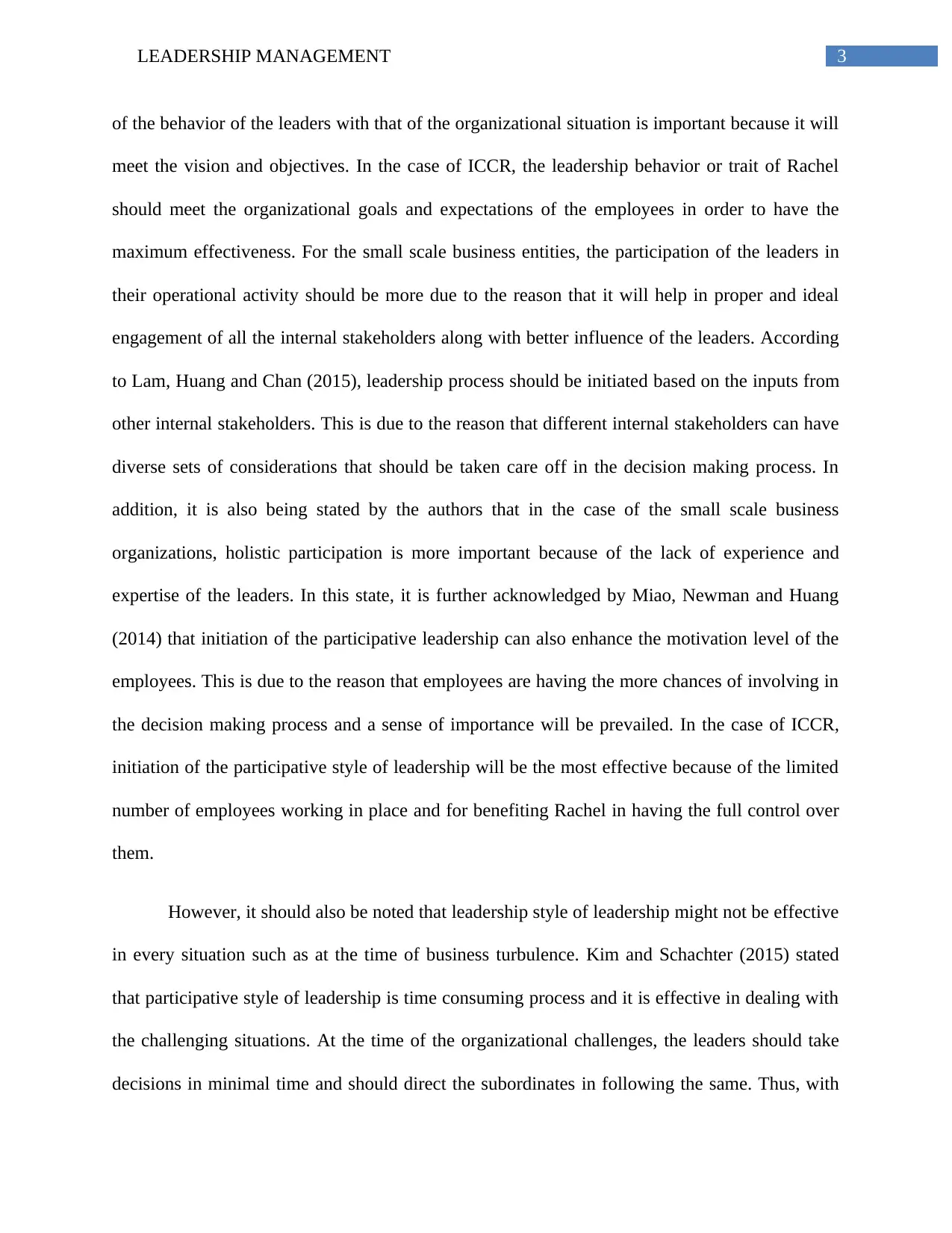
3LEADERSHIP MANAGEMENT
of the behavior of the leaders with that of the organizational situation is important because it will
meet the vision and objectives. In the case of ICCR, the leadership behavior or trait of Rachel
should meet the organizational goals and expectations of the employees in order to have the
maximum effectiveness. For the small scale business entities, the participation of the leaders in
their operational activity should be more due to the reason that it will help in proper and ideal
engagement of all the internal stakeholders along with better influence of the leaders. According
to Lam, Huang and Chan (2015), leadership process should be initiated based on the inputs from
other internal stakeholders. This is due to the reason that different internal stakeholders can have
diverse sets of considerations that should be taken care off in the decision making process. In
addition, it is also being stated by the authors that in the case of the small scale business
organizations, holistic participation is more important because of the lack of experience and
expertise of the leaders. In this state, it is further acknowledged by Miao, Newman and Huang
(2014) that initiation of the participative leadership can also enhance the motivation level of the
employees. This is due to the reason that employees are having the more chances of involving in
the decision making process and a sense of importance will be prevailed. In the case of ICCR,
initiation of the participative style of leadership will be the most effective because of the limited
number of employees working in place and for benefiting Rachel in having the full control over
them.
However, it should also be noted that leadership style of leadership might not be effective
in every situation such as at the time of business turbulence. Kim and Schachter (2015) stated
that participative style of leadership is time consuming process and it is effective in dealing with
the challenging situations. At the time of the organizational challenges, the leaders should take
decisions in minimal time and should direct the subordinates in following the same. Thus, with
of the behavior of the leaders with that of the organizational situation is important because it will
meet the vision and objectives. In the case of ICCR, the leadership behavior or trait of Rachel
should meet the organizational goals and expectations of the employees in order to have the
maximum effectiveness. For the small scale business entities, the participation of the leaders in
their operational activity should be more due to the reason that it will help in proper and ideal
engagement of all the internal stakeholders along with better influence of the leaders. According
to Lam, Huang and Chan (2015), leadership process should be initiated based on the inputs from
other internal stakeholders. This is due to the reason that different internal stakeholders can have
diverse sets of considerations that should be taken care off in the decision making process. In
addition, it is also being stated by the authors that in the case of the small scale business
organizations, holistic participation is more important because of the lack of experience and
expertise of the leaders. In this state, it is further acknowledged by Miao, Newman and Huang
(2014) that initiation of the participative leadership can also enhance the motivation level of the
employees. This is due to the reason that employees are having the more chances of involving in
the decision making process and a sense of importance will be prevailed. In the case of ICCR,
initiation of the participative style of leadership will be the most effective because of the limited
number of employees working in place and for benefiting Rachel in having the full control over
them.
However, it should also be noted that leadership style of leadership might not be effective
in every situation such as at the time of business turbulence. Kim and Schachter (2015) stated
that participative style of leadership is time consuming process and it is effective in dealing with
the challenging situations. At the time of the organizational challenges, the leaders should take
decisions in minimal time and should direct the subordinates in following the same. Thus, with
Paraphrase This Document
Need a fresh take? Get an instant paraphrase of this document with our AI Paraphraser
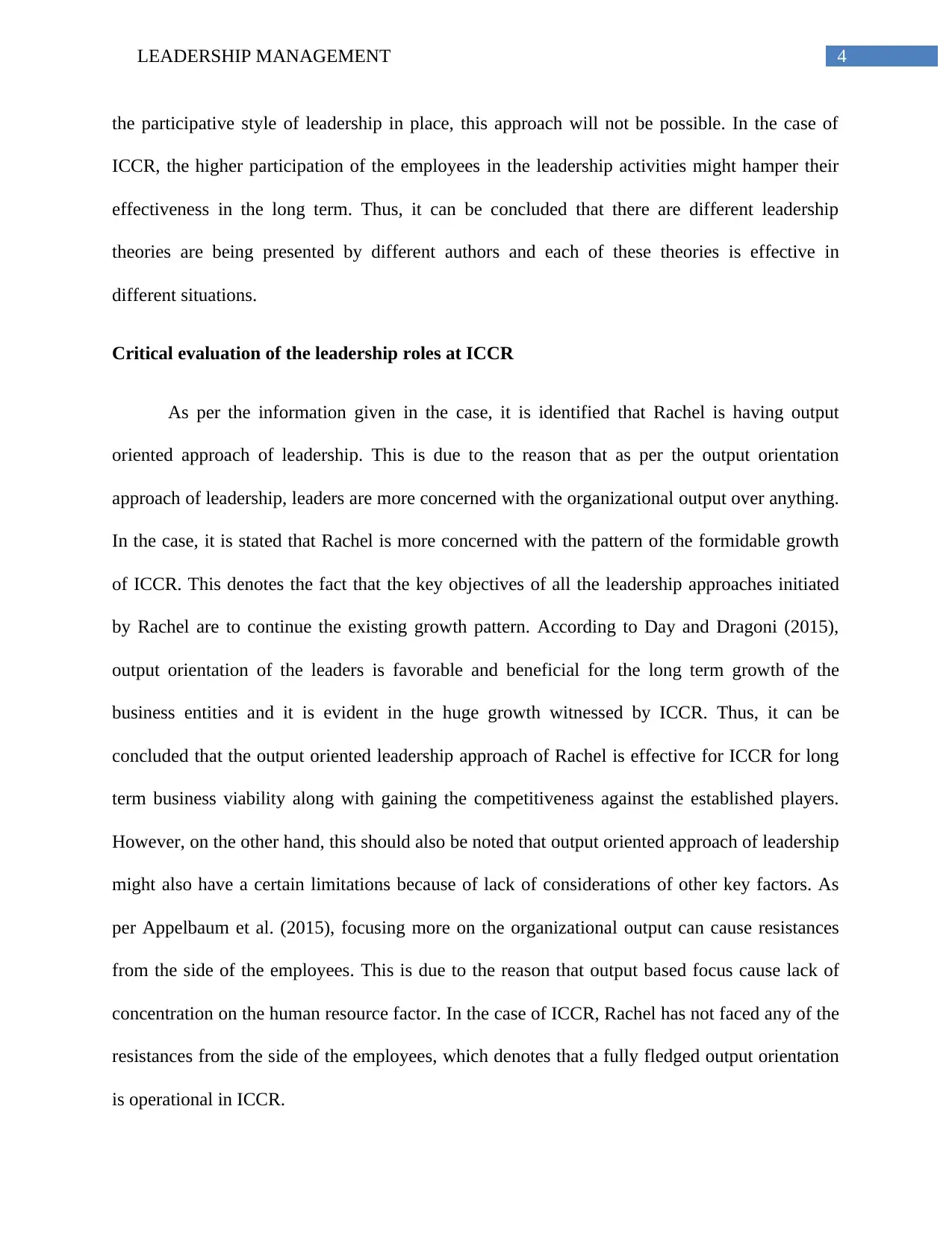
4LEADERSHIP MANAGEMENT
the participative style of leadership in place, this approach will not be possible. In the case of
ICCR, the higher participation of the employees in the leadership activities might hamper their
effectiveness in the long term. Thus, it can be concluded that there are different leadership
theories are being presented by different authors and each of these theories is effective in
different situations.
Critical evaluation of the leadership roles at ICCR
As per the information given in the case, it is identified that Rachel is having output
oriented approach of leadership. This is due to the reason that as per the output orientation
approach of leadership, leaders are more concerned with the organizational output over anything.
In the case, it is stated that Rachel is more concerned with the pattern of the formidable growth
of ICCR. This denotes the fact that the key objectives of all the leadership approaches initiated
by Rachel are to continue the existing growth pattern. According to Day and Dragoni (2015),
output orientation of the leaders is favorable and beneficial for the long term growth of the
business entities and it is evident in the huge growth witnessed by ICCR. Thus, it can be
concluded that the output oriented leadership approach of Rachel is effective for ICCR for long
term business viability along with gaining the competitiveness against the established players.
However, on the other hand, this should also be noted that output oriented approach of leadership
might also have a certain limitations because of lack of considerations of other key factors. As
per Appelbaum et al. (2015), focusing more on the organizational output can cause resistances
from the side of the employees. This is due to the reason that output based focus cause lack of
concentration on the human resource factor. In the case of ICCR, Rachel has not faced any of the
resistances from the side of the employees, which denotes that a fully fledged output orientation
is operational in ICCR.
the participative style of leadership in place, this approach will not be possible. In the case of
ICCR, the higher participation of the employees in the leadership activities might hamper their
effectiveness in the long term. Thus, it can be concluded that there are different leadership
theories are being presented by different authors and each of these theories is effective in
different situations.
Critical evaluation of the leadership roles at ICCR
As per the information given in the case, it is identified that Rachel is having output
oriented approach of leadership. This is due to the reason that as per the output orientation
approach of leadership, leaders are more concerned with the organizational output over anything.
In the case, it is stated that Rachel is more concerned with the pattern of the formidable growth
of ICCR. This denotes the fact that the key objectives of all the leadership approaches initiated
by Rachel are to continue the existing growth pattern. According to Day and Dragoni (2015),
output orientation of the leaders is favorable and beneficial for the long term growth of the
business entities and it is evident in the huge growth witnessed by ICCR. Thus, it can be
concluded that the output oriented leadership approach of Rachel is effective for ICCR for long
term business viability along with gaining the competitiveness against the established players.
However, on the other hand, this should also be noted that output oriented approach of leadership
might also have a certain limitations because of lack of considerations of other key factors. As
per Appelbaum et al. (2015), focusing more on the organizational output can cause resistances
from the side of the employees. This is due to the reason that output based focus cause lack of
concentration on the human resource factor. In the case of ICCR, Rachel has not faced any of the
resistances from the side of the employees, which denotes that a fully fledged output orientation
is operational in ICCR.
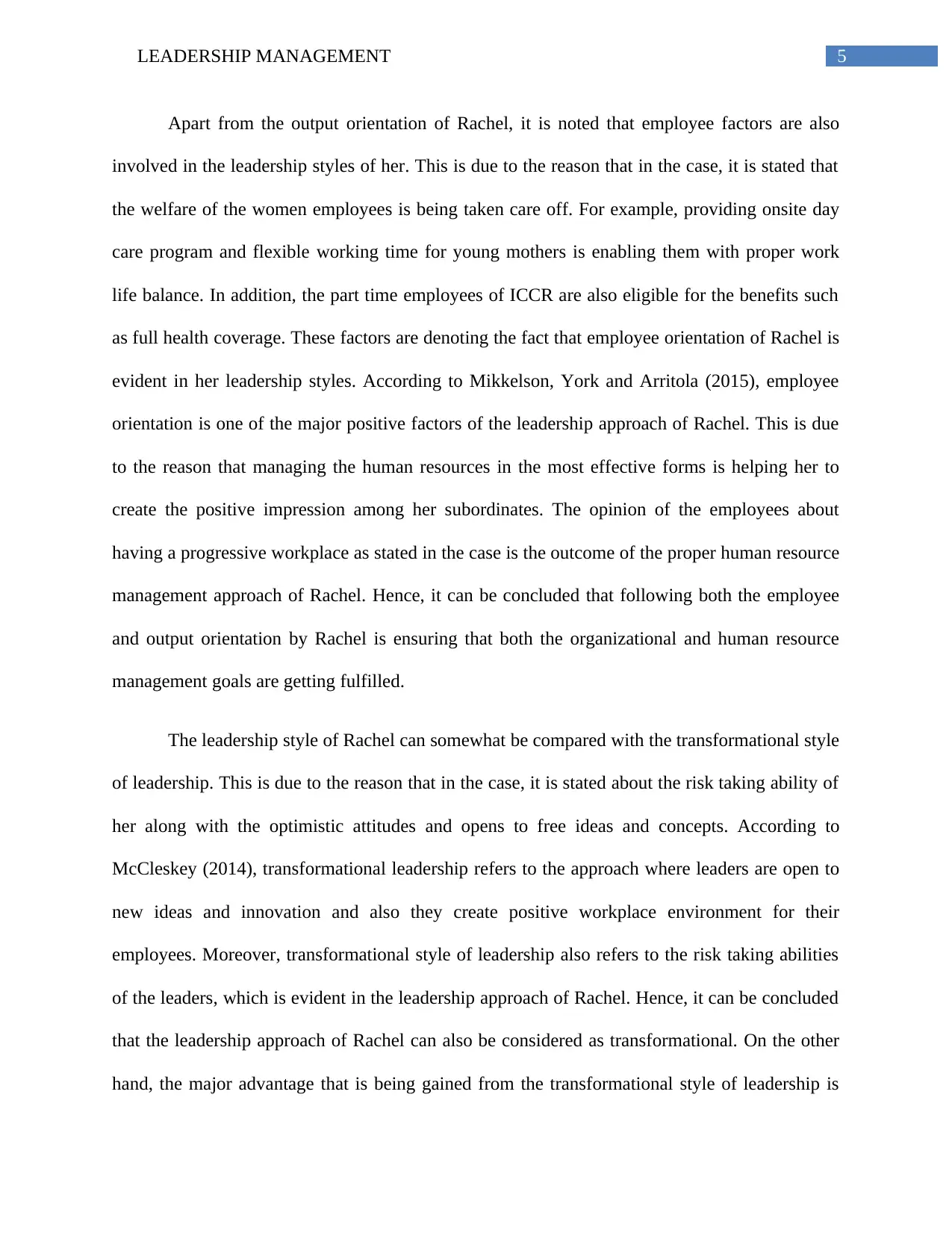
5LEADERSHIP MANAGEMENT
Apart from the output orientation of Rachel, it is noted that employee factors are also
involved in the leadership styles of her. This is due to the reason that in the case, it is stated that
the welfare of the women employees is being taken care off. For example, providing onsite day
care program and flexible working time for young mothers is enabling them with proper work
life balance. In addition, the part time employees of ICCR are also eligible for the benefits such
as full health coverage. These factors are denoting the fact that employee orientation of Rachel is
evident in her leadership styles. According to Mikkelson, York and Arritola (2015), employee
orientation is one of the major positive factors of the leadership approach of Rachel. This is due
to the reason that managing the human resources in the most effective forms is helping her to
create the positive impression among her subordinates. The opinion of the employees about
having a progressive workplace as stated in the case is the outcome of the proper human resource
management approach of Rachel. Hence, it can be concluded that following both the employee
and output orientation by Rachel is ensuring that both the organizational and human resource
management goals are getting fulfilled.
The leadership style of Rachel can somewhat be compared with the transformational style
of leadership. This is due to the reason that in the case, it is stated about the risk taking ability of
her along with the optimistic attitudes and opens to free ideas and concepts. According to
McCleskey (2014), transformational leadership refers to the approach where leaders are open to
new ideas and innovation and also they create positive workplace environment for their
employees. Moreover, transformational style of leadership also refers to the risk taking abilities
of the leaders, which is evident in the leadership approach of Rachel. Hence, it can be concluded
that the leadership approach of Rachel can also be considered as transformational. On the other
hand, the major advantage that is being gained from the transformational style of leadership is
Apart from the output orientation of Rachel, it is noted that employee factors are also
involved in the leadership styles of her. This is due to the reason that in the case, it is stated that
the welfare of the women employees is being taken care off. For example, providing onsite day
care program and flexible working time for young mothers is enabling them with proper work
life balance. In addition, the part time employees of ICCR are also eligible for the benefits such
as full health coverage. These factors are denoting the fact that employee orientation of Rachel is
evident in her leadership styles. According to Mikkelson, York and Arritola (2015), employee
orientation is one of the major positive factors of the leadership approach of Rachel. This is due
to the reason that managing the human resources in the most effective forms is helping her to
create the positive impression among her subordinates. The opinion of the employees about
having a progressive workplace as stated in the case is the outcome of the proper human resource
management approach of Rachel. Hence, it can be concluded that following both the employee
and output orientation by Rachel is ensuring that both the organizational and human resource
management goals are getting fulfilled.
The leadership style of Rachel can somewhat be compared with the transformational style
of leadership. This is due to the reason that in the case, it is stated about the risk taking ability of
her along with the optimistic attitudes and opens to free ideas and concepts. According to
McCleskey (2014), transformational leadership refers to the approach where leaders are open to
new ideas and innovation and also they create positive workplace environment for their
employees. Moreover, transformational style of leadership also refers to the risk taking abilities
of the leaders, which is evident in the leadership approach of Rachel. Hence, it can be concluded
that the leadership approach of Rachel can also be considered as transformational. On the other
hand, the major advantage that is being gained from the transformational style of leadership is
⊘ This is a preview!⊘
Do you want full access?
Subscribe today to unlock all pages.

Trusted by 1+ million students worldwide
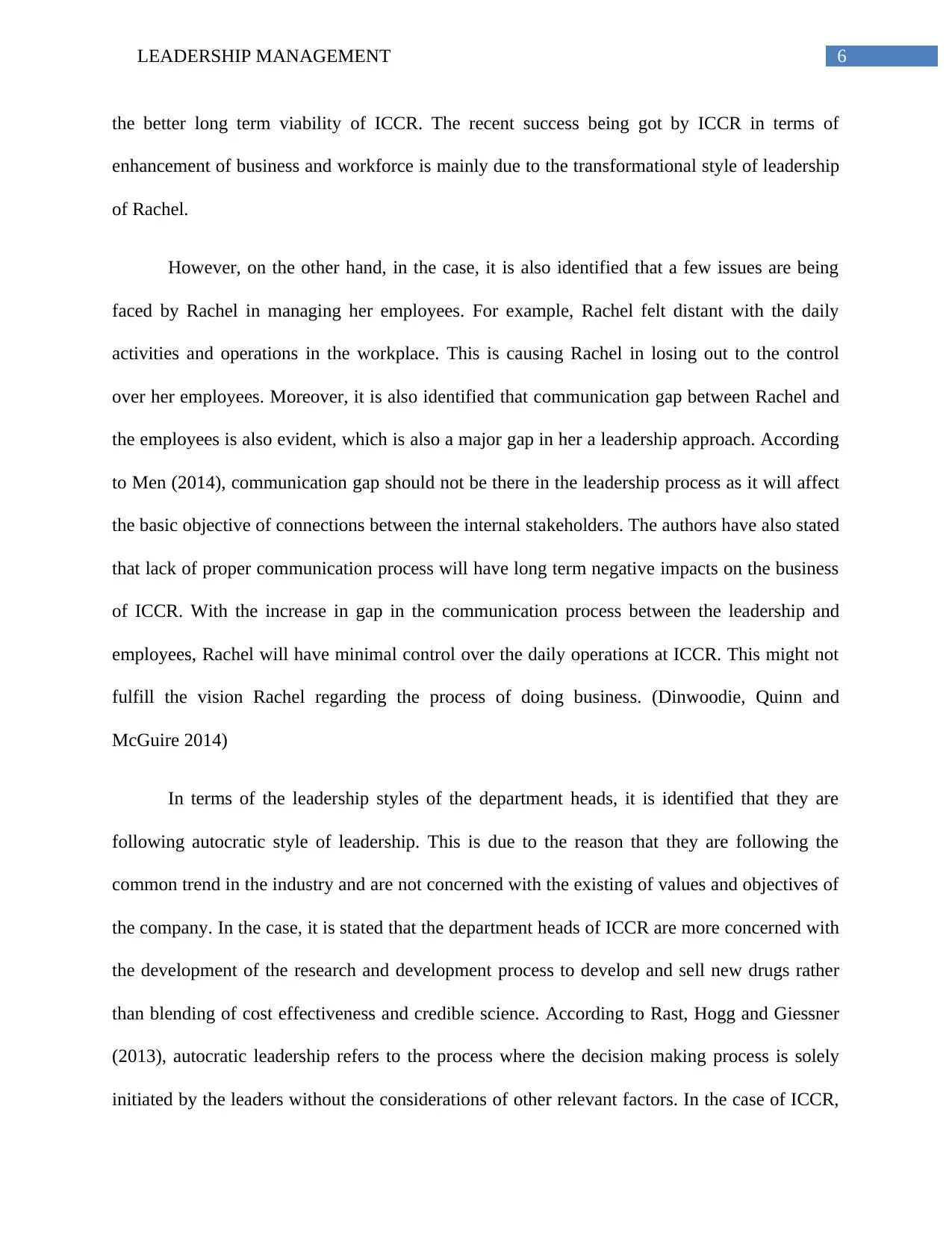
6LEADERSHIP MANAGEMENT
the better long term viability of ICCR. The recent success being got by ICCR in terms of
enhancement of business and workforce is mainly due to the transformational style of leadership
of Rachel.
However, on the other hand, in the case, it is also identified that a few issues are being
faced by Rachel in managing her employees. For example, Rachel felt distant with the daily
activities and operations in the workplace. This is causing Rachel in losing out to the control
over her employees. Moreover, it is also identified that communication gap between Rachel and
the employees is also evident, which is also a major gap in her a leadership approach. According
to Men (2014), communication gap should not be there in the leadership process as it will affect
the basic objective of connections between the internal stakeholders. The authors have also stated
that lack of proper communication process will have long term negative impacts on the business
of ICCR. With the increase in gap in the communication process between the leadership and
employees, Rachel will have minimal control over the daily operations at ICCR. This might not
fulfill the vision Rachel regarding the process of doing business. (Dinwoodie, Quinn and
McGuire 2014)
In terms of the leadership styles of the department heads, it is identified that they are
following autocratic style of leadership. This is due to the reason that they are following the
common trend in the industry and are not concerned with the existing of values and objectives of
the company. In the case, it is stated that the department heads of ICCR are more concerned with
the development of the research and development process to develop and sell new drugs rather
than blending of cost effectiveness and credible science. According to Rast, Hogg and Giessner
(2013), autocratic leadership refers to the process where the decision making process is solely
initiated by the leaders without the considerations of other relevant factors. In the case of ICCR,
the better long term viability of ICCR. The recent success being got by ICCR in terms of
enhancement of business and workforce is mainly due to the transformational style of leadership
of Rachel.
However, on the other hand, in the case, it is also identified that a few issues are being
faced by Rachel in managing her employees. For example, Rachel felt distant with the daily
activities and operations in the workplace. This is causing Rachel in losing out to the control
over her employees. Moreover, it is also identified that communication gap between Rachel and
the employees is also evident, which is also a major gap in her a leadership approach. According
to Men (2014), communication gap should not be there in the leadership process as it will affect
the basic objective of connections between the internal stakeholders. The authors have also stated
that lack of proper communication process will have long term negative impacts on the business
of ICCR. With the increase in gap in the communication process between the leadership and
employees, Rachel will have minimal control over the daily operations at ICCR. This might not
fulfill the vision Rachel regarding the process of doing business. (Dinwoodie, Quinn and
McGuire 2014)
In terms of the leadership styles of the department heads, it is identified that they are
following autocratic style of leadership. This is due to the reason that they are following the
common trend in the industry and are not concerned with the existing of values and objectives of
the company. In the case, it is stated that the department heads of ICCR are more concerned with
the development of the research and development process to develop and sell new drugs rather
than blending of cost effectiveness and credible science. According to Rast, Hogg and Giessner
(2013), autocratic leadership refers to the process where the decision making process is solely
initiated by the leaders without the considerations of other relevant factors. In the case of ICCR,
Paraphrase This Document
Need a fresh take? Get an instant paraphrase of this document with our AI Paraphraser
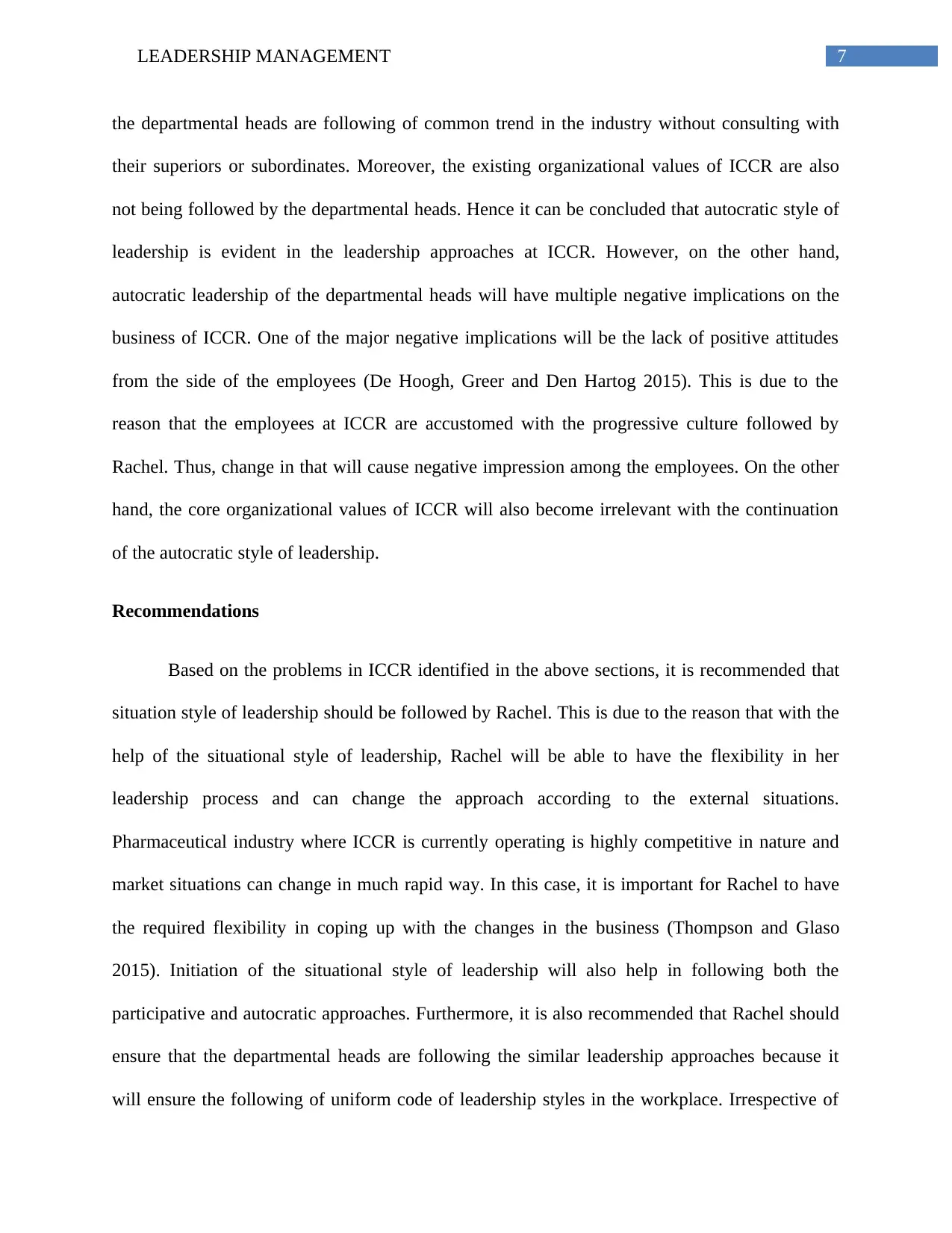
7LEADERSHIP MANAGEMENT
the departmental heads are following of common trend in the industry without consulting with
their superiors or subordinates. Moreover, the existing organizational values of ICCR are also
not being followed by the departmental heads. Hence it can be concluded that autocratic style of
leadership is evident in the leadership approaches at ICCR. However, on the other hand,
autocratic leadership of the departmental heads will have multiple negative implications on the
business of ICCR. One of the major negative implications will be the lack of positive attitudes
from the side of the employees (De Hoogh, Greer and Den Hartog 2015). This is due to the
reason that the employees at ICCR are accustomed with the progressive culture followed by
Rachel. Thus, change in that will cause negative impression among the employees. On the other
hand, the core organizational values of ICCR will also become irrelevant with the continuation
of the autocratic style of leadership.
Recommendations
Based on the problems in ICCR identified in the above sections, it is recommended that
situation style of leadership should be followed by Rachel. This is due to the reason that with the
help of the situational style of leadership, Rachel will be able to have the flexibility in her
leadership process and can change the approach according to the external situations.
Pharmaceutical industry where ICCR is currently operating is highly competitive in nature and
market situations can change in much rapid way. In this case, it is important for Rachel to have
the required flexibility in coping up with the changes in the business (Thompson and Glaso
2015). Initiation of the situational style of leadership will also help in following both the
participative and autocratic approaches. Furthermore, it is also recommended that Rachel should
ensure that the departmental heads are following the similar leadership approaches because it
will ensure the following of uniform code of leadership styles in the workplace. Irrespective of
the departmental heads are following of common trend in the industry without consulting with
their superiors or subordinates. Moreover, the existing organizational values of ICCR are also
not being followed by the departmental heads. Hence it can be concluded that autocratic style of
leadership is evident in the leadership approaches at ICCR. However, on the other hand,
autocratic leadership of the departmental heads will have multiple negative implications on the
business of ICCR. One of the major negative implications will be the lack of positive attitudes
from the side of the employees (De Hoogh, Greer and Den Hartog 2015). This is due to the
reason that the employees at ICCR are accustomed with the progressive culture followed by
Rachel. Thus, change in that will cause negative impression among the employees. On the other
hand, the core organizational values of ICCR will also become irrelevant with the continuation
of the autocratic style of leadership.
Recommendations
Based on the problems in ICCR identified in the above sections, it is recommended that
situation style of leadership should be followed by Rachel. This is due to the reason that with the
help of the situational style of leadership, Rachel will be able to have the flexibility in her
leadership process and can change the approach according to the external situations.
Pharmaceutical industry where ICCR is currently operating is highly competitive in nature and
market situations can change in much rapid way. In this case, it is important for Rachel to have
the required flexibility in coping up with the changes in the business (Thompson and Glaso
2015). Initiation of the situational style of leadership will also help in following both the
participative and autocratic approaches. Furthermore, it is also recommended that Rachel should
ensure that the departmental heads are following the similar leadership approaches because it
will ensure the following of uniform code of leadership styles in the workplace. Irrespective of
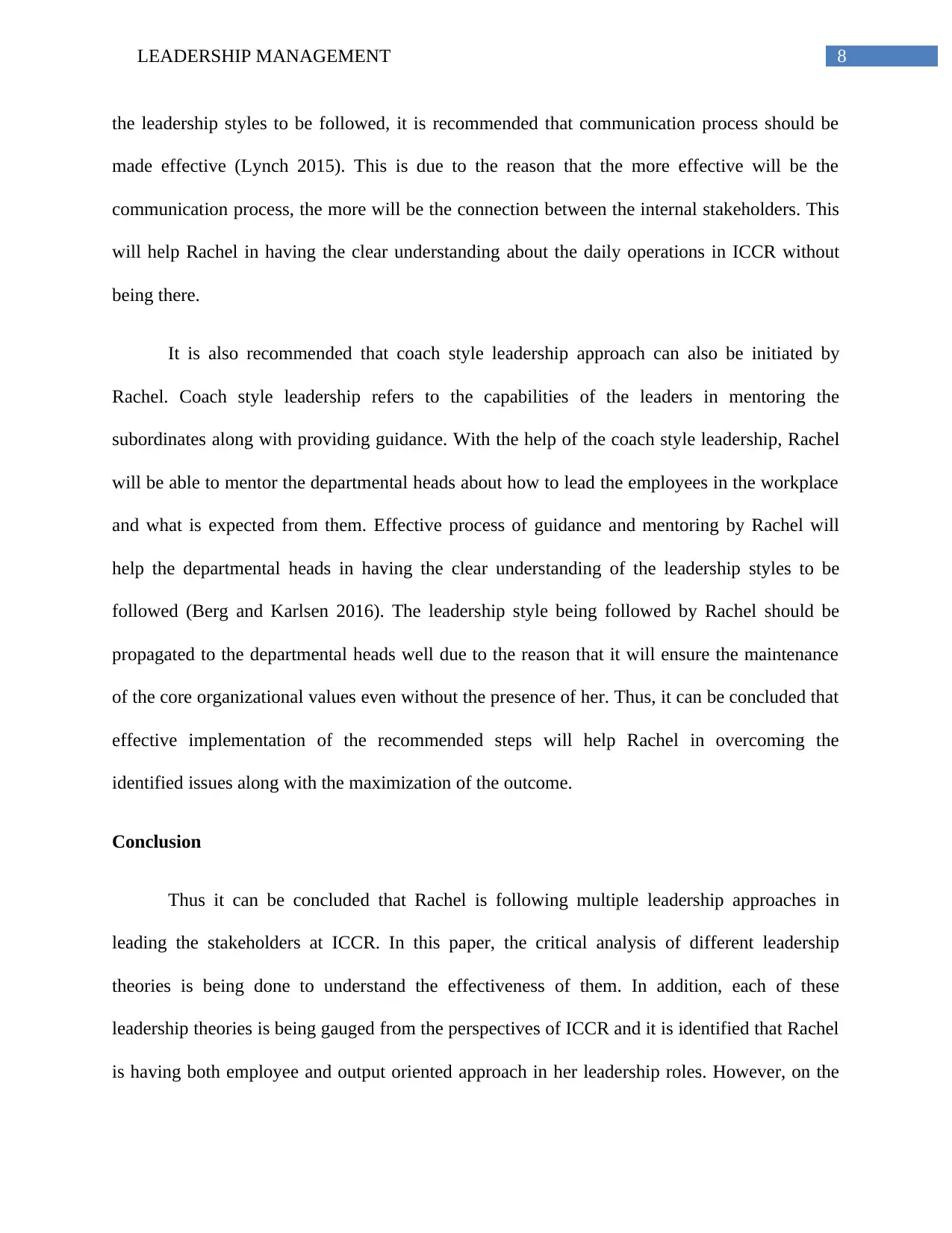
8LEADERSHIP MANAGEMENT
the leadership styles to be followed, it is recommended that communication process should be
made effective (Lynch 2015). This is due to the reason that the more effective will be the
communication process, the more will be the connection between the internal stakeholders. This
will help Rachel in having the clear understanding about the daily operations in ICCR without
being there.
It is also recommended that coach style leadership approach can also be initiated by
Rachel. Coach style leadership refers to the capabilities of the leaders in mentoring the
subordinates along with providing guidance. With the help of the coach style leadership, Rachel
will be able to mentor the departmental heads about how to lead the employees in the workplace
and what is expected from them. Effective process of guidance and mentoring by Rachel will
help the departmental heads in having the clear understanding of the leadership styles to be
followed (Berg and Karlsen 2016). The leadership style being followed by Rachel should be
propagated to the departmental heads well due to the reason that it will ensure the maintenance
of the core organizational values even without the presence of her. Thus, it can be concluded that
effective implementation of the recommended steps will help Rachel in overcoming the
identified issues along with the maximization of the outcome.
Conclusion
Thus it can be concluded that Rachel is following multiple leadership approaches in
leading the stakeholders at ICCR. In this paper, the critical analysis of different leadership
theories is being done to understand the effectiveness of them. In addition, each of these
leadership theories is being gauged from the perspectives of ICCR and it is identified that Rachel
is having both employee and output oriented approach in her leadership roles. However, on the
the leadership styles to be followed, it is recommended that communication process should be
made effective (Lynch 2015). This is due to the reason that the more effective will be the
communication process, the more will be the connection between the internal stakeholders. This
will help Rachel in having the clear understanding about the daily operations in ICCR without
being there.
It is also recommended that coach style leadership approach can also be initiated by
Rachel. Coach style leadership refers to the capabilities of the leaders in mentoring the
subordinates along with providing guidance. With the help of the coach style leadership, Rachel
will be able to mentor the departmental heads about how to lead the employees in the workplace
and what is expected from them. Effective process of guidance and mentoring by Rachel will
help the departmental heads in having the clear understanding of the leadership styles to be
followed (Berg and Karlsen 2016). The leadership style being followed by Rachel should be
propagated to the departmental heads well due to the reason that it will ensure the maintenance
of the core organizational values even without the presence of her. Thus, it can be concluded that
effective implementation of the recommended steps will help Rachel in overcoming the
identified issues along with the maximization of the outcome.
Conclusion
Thus it can be concluded that Rachel is following multiple leadership approaches in
leading the stakeholders at ICCR. In this paper, the critical analysis of different leadership
theories is being done to understand the effectiveness of them. In addition, each of these
leadership theories is being gauged from the perspectives of ICCR and it is identified that Rachel
is having both employee and output oriented approach in her leadership roles. However, on the
⊘ This is a preview!⊘
Do you want full access?
Subscribe today to unlock all pages.

Trusted by 1+ million students worldwide
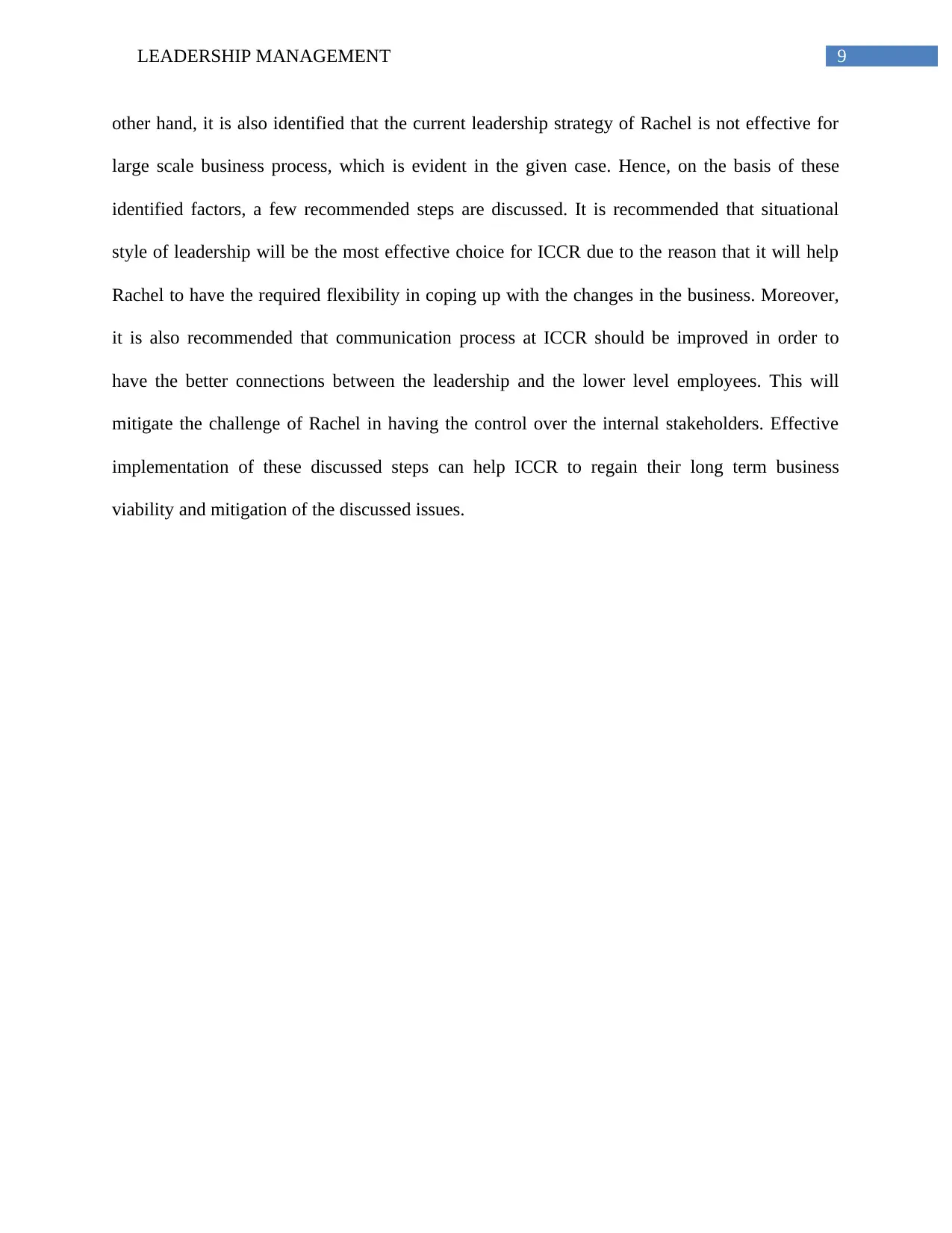
9LEADERSHIP MANAGEMENT
other hand, it is also identified that the current leadership strategy of Rachel is not effective for
large scale business process, which is evident in the given case. Hence, on the basis of these
identified factors, a few recommended steps are discussed. It is recommended that situational
style of leadership will be the most effective choice for ICCR due to the reason that it will help
Rachel to have the required flexibility in coping up with the changes in the business. Moreover,
it is also recommended that communication process at ICCR should be improved in order to
have the better connections between the leadership and the lower level employees. This will
mitigate the challenge of Rachel in having the control over the internal stakeholders. Effective
implementation of these discussed steps can help ICCR to regain their long term business
viability and mitigation of the discussed issues.
other hand, it is also identified that the current leadership strategy of Rachel is not effective for
large scale business process, which is evident in the given case. Hence, on the basis of these
identified factors, a few recommended steps are discussed. It is recommended that situational
style of leadership will be the most effective choice for ICCR due to the reason that it will help
Rachel to have the required flexibility in coping up with the changes in the business. Moreover,
it is also recommended that communication process at ICCR should be improved in order to
have the better connections between the leadership and the lower level employees. This will
mitigate the challenge of Rachel in having the control over the internal stakeholders. Effective
implementation of these discussed steps can help ICCR to regain their long term business
viability and mitigation of the discussed issues.
Paraphrase This Document
Need a fresh take? Get an instant paraphrase of this document with our AI Paraphraser
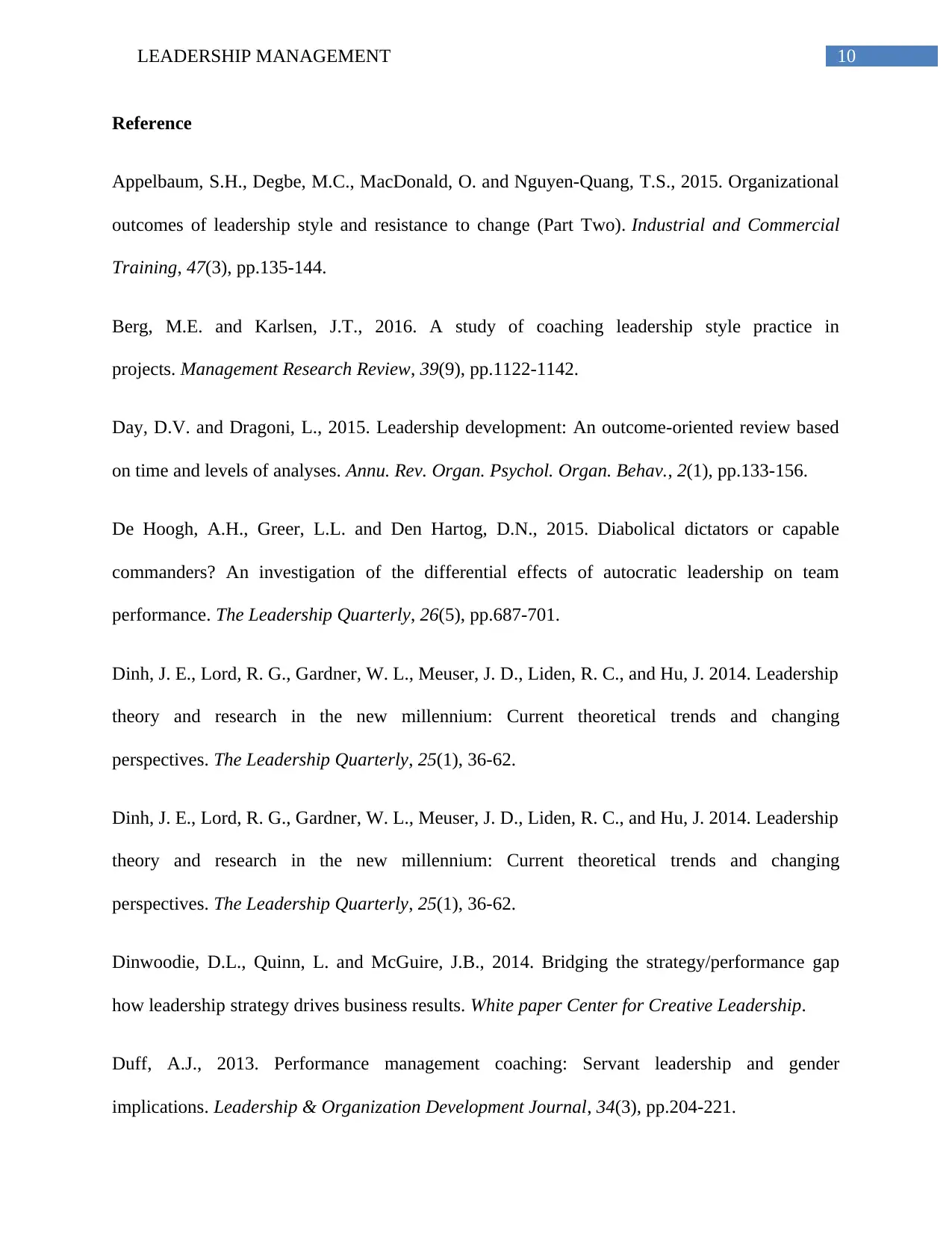
10LEADERSHIP MANAGEMENT
Reference
Appelbaum, S.H., Degbe, M.C., MacDonald, O. and Nguyen-Quang, T.S., 2015. Organizational
outcomes of leadership style and resistance to change (Part Two). Industrial and Commercial
Training, 47(3), pp.135-144.
Berg, M.E. and Karlsen, J.T., 2016. A study of coaching leadership style practice in
projects. Management Research Review, 39(9), pp.1122-1142.
Day, D.V. and Dragoni, L., 2015. Leadership development: An outcome-oriented review based
on time and levels of analyses. Annu. Rev. Organ. Psychol. Organ. Behav., 2(1), pp.133-156.
De Hoogh, A.H., Greer, L.L. and Den Hartog, D.N., 2015. Diabolical dictators or capable
commanders? An investigation of the differential effects of autocratic leadership on team
performance. The Leadership Quarterly, 26(5), pp.687-701.
Dinh, J. E., Lord, R. G., Gardner, W. L., Meuser, J. D., Liden, R. C., and Hu, J. 2014. Leadership
theory and research in the new millennium: Current theoretical trends and changing
perspectives. The Leadership Quarterly, 25(1), 36-62.
Dinh, J. E., Lord, R. G., Gardner, W. L., Meuser, J. D., Liden, R. C., and Hu, J. 2014. Leadership
theory and research in the new millennium: Current theoretical trends and changing
perspectives. The Leadership Quarterly, 25(1), 36-62.
Dinwoodie, D.L., Quinn, L. and McGuire, J.B., 2014. Bridging the strategy/performance gap
how leadership strategy drives business results. White paper Center for Creative Leadership.
Duff, A.J., 2013. Performance management coaching: Servant leadership and gender
implications. Leadership & Organization Development Journal, 34(3), pp.204-221.
Reference
Appelbaum, S.H., Degbe, M.C., MacDonald, O. and Nguyen-Quang, T.S., 2015. Organizational
outcomes of leadership style and resistance to change (Part Two). Industrial and Commercial
Training, 47(3), pp.135-144.
Berg, M.E. and Karlsen, J.T., 2016. A study of coaching leadership style practice in
projects. Management Research Review, 39(9), pp.1122-1142.
Day, D.V. and Dragoni, L., 2015. Leadership development: An outcome-oriented review based
on time and levels of analyses. Annu. Rev. Organ. Psychol. Organ. Behav., 2(1), pp.133-156.
De Hoogh, A.H., Greer, L.L. and Den Hartog, D.N., 2015. Diabolical dictators or capable
commanders? An investigation of the differential effects of autocratic leadership on team
performance. The Leadership Quarterly, 26(5), pp.687-701.
Dinh, J. E., Lord, R. G., Gardner, W. L., Meuser, J. D., Liden, R. C., and Hu, J. 2014. Leadership
theory and research in the new millennium: Current theoretical trends and changing
perspectives. The Leadership Quarterly, 25(1), 36-62.
Dinh, J. E., Lord, R. G., Gardner, W. L., Meuser, J. D., Liden, R. C., and Hu, J. 2014. Leadership
theory and research in the new millennium: Current theoretical trends and changing
perspectives. The Leadership Quarterly, 25(1), 36-62.
Dinwoodie, D.L., Quinn, L. and McGuire, J.B., 2014. Bridging the strategy/performance gap
how leadership strategy drives business results. White paper Center for Creative Leadership.
Duff, A.J., 2013. Performance management coaching: Servant leadership and gender
implications. Leadership & Organization Development Journal, 34(3), pp.204-221.
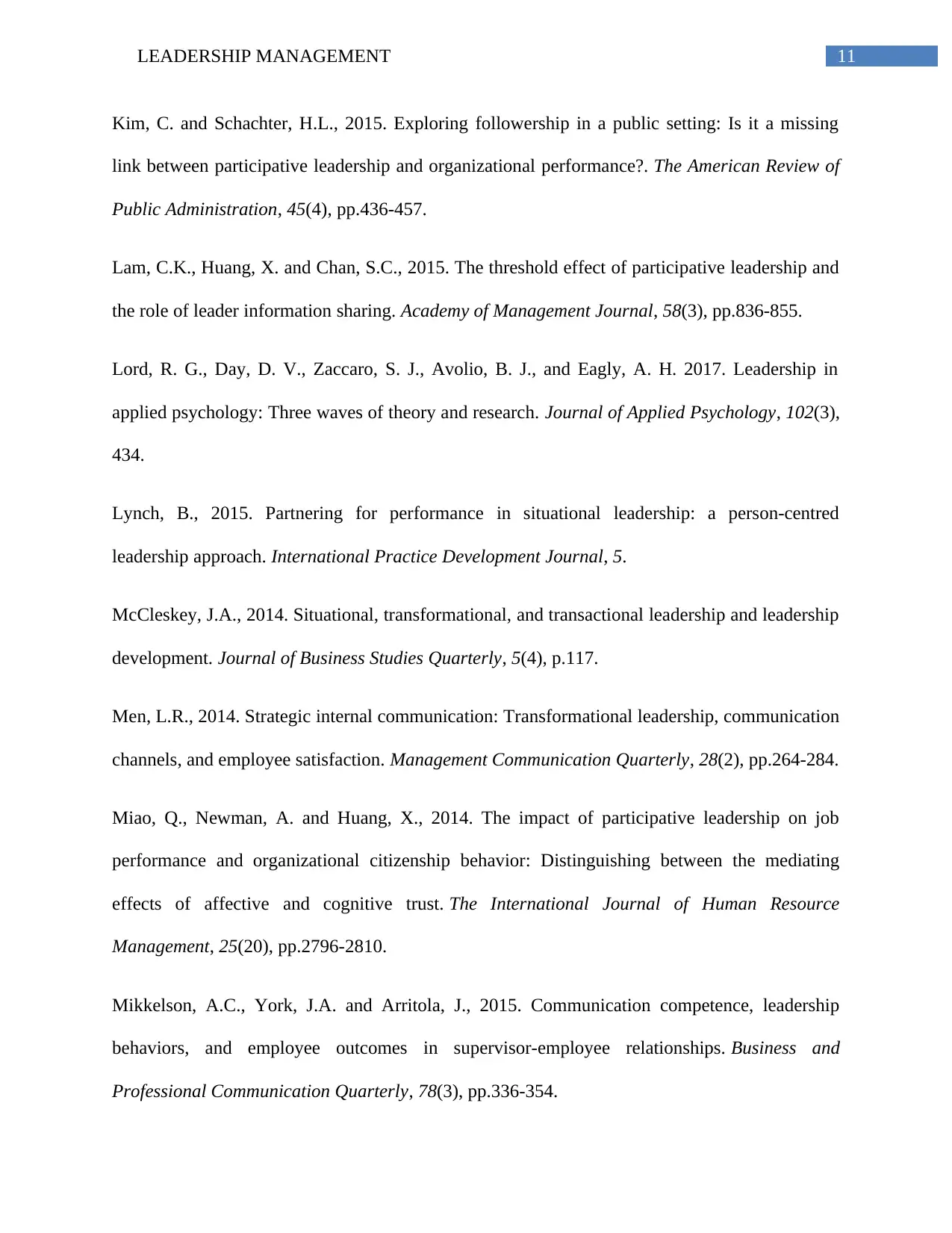
11LEADERSHIP MANAGEMENT
Kim, C. and Schachter, H.L., 2015. Exploring followership in a public setting: Is it a missing
link between participative leadership and organizational performance?. The American Review of
Public Administration, 45(4), pp.436-457.
Lam, C.K., Huang, X. and Chan, S.C., 2015. The threshold effect of participative leadership and
the role of leader information sharing. Academy of Management Journal, 58(3), pp.836-855.
Lord, R. G., Day, D. V., Zaccaro, S. J., Avolio, B. J., and Eagly, A. H. 2017. Leadership in
applied psychology: Three waves of theory and research. Journal of Applied Psychology, 102(3),
434.
Lynch, B., 2015. Partnering for performance in situational leadership: a person-centred
leadership approach. International Practice Development Journal, 5.
McCleskey, J.A., 2014. Situational, transformational, and transactional leadership and leadership
development. Journal of Business Studies Quarterly, 5(4), p.117.
Men, L.R., 2014. Strategic internal communication: Transformational leadership, communication
channels, and employee satisfaction. Management Communication Quarterly, 28(2), pp.264-284.
Miao, Q., Newman, A. and Huang, X., 2014. The impact of participative leadership on job
performance and organizational citizenship behavior: Distinguishing between the mediating
effects of affective and cognitive trust. The International Journal of Human Resource
Management, 25(20), pp.2796-2810.
Mikkelson, A.C., York, J.A. and Arritola, J., 2015. Communication competence, leadership
behaviors, and employee outcomes in supervisor-employee relationships. Business and
Professional Communication Quarterly, 78(3), pp.336-354.
Kim, C. and Schachter, H.L., 2015. Exploring followership in a public setting: Is it a missing
link between participative leadership and organizational performance?. The American Review of
Public Administration, 45(4), pp.436-457.
Lam, C.K., Huang, X. and Chan, S.C., 2015. The threshold effect of participative leadership and
the role of leader information sharing. Academy of Management Journal, 58(3), pp.836-855.
Lord, R. G., Day, D. V., Zaccaro, S. J., Avolio, B. J., and Eagly, A. H. 2017. Leadership in
applied psychology: Three waves of theory and research. Journal of Applied Psychology, 102(3),
434.
Lynch, B., 2015. Partnering for performance in situational leadership: a person-centred
leadership approach. International Practice Development Journal, 5.
McCleskey, J.A., 2014. Situational, transformational, and transactional leadership and leadership
development. Journal of Business Studies Quarterly, 5(4), p.117.
Men, L.R., 2014. Strategic internal communication: Transformational leadership, communication
channels, and employee satisfaction. Management Communication Quarterly, 28(2), pp.264-284.
Miao, Q., Newman, A. and Huang, X., 2014. The impact of participative leadership on job
performance and organizational citizenship behavior: Distinguishing between the mediating
effects of affective and cognitive trust. The International Journal of Human Resource
Management, 25(20), pp.2796-2810.
Mikkelson, A.C., York, J.A. and Arritola, J., 2015. Communication competence, leadership
behaviors, and employee outcomes in supervisor-employee relationships. Business and
Professional Communication Quarterly, 78(3), pp.336-354.
⊘ This is a preview!⊘
Do you want full access?
Subscribe today to unlock all pages.

Trusted by 1+ million students worldwide
1 out of 13
Related Documents
Your All-in-One AI-Powered Toolkit for Academic Success.
+13062052269
info@desklib.com
Available 24*7 on WhatsApp / Email
![[object Object]](/_next/static/media/star-bottom.7253800d.svg)
Unlock your academic potential
Copyright © 2020–2025 A2Z Services. All Rights Reserved. Developed and managed by ZUCOL.





